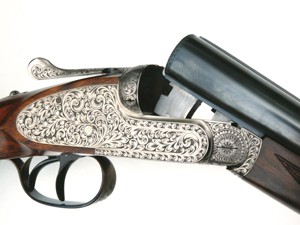AyA No.1 Deluxe 20-bore shotgun review

AyA No.1 Deluxe 20-bore shotgun review
Manufacturer: Aya
Classic simplicity
The styling of the No.1 is one of classic simplicity, following down the lines of most London Best bar-lock sidelocks, an evolution of design that has rarely, if ever, been bettered.
Steel and wood merge together to form an aesthetically pleasing, yet wholly practical and well-balanced gun that feels even lighter than its modest 6lb 2oz.
A profusion of engraving vies with colour-case hardened steel and blacked barrels for attention but nothing is vulgar, each part complements the other. It is the kind of gun that, as you turn it over between the hands, subtle new features are revealed, maybe only some small attention to detail but one that indicates the care that has gone into the making of this gun.
Satisfying detail
Initially it is the action that draws the eye because it is undeniably striking with the crisp and rather bold hand-engraving, similar to some late 19th-century English patterns.
Just to prove its authenticity, under close examination a trace of the original layout lines used by the engraver are just visible. Even that small and somewhat overlooked item ‘SAFE’ in front of the safety button is seen, under the scrutiny of a magnifying glass, very well inlaid.
The trigger-plate, the inside of the trigger-guard, fore-end iron stale, action flats and the face of the standing breech where engraving would be inappropriate show the subtle autumnal colourings of case hardening.
Self-opener
An optional feature of the gun is the self-opening mechanism. This essentially consists of two telescoped tubes containing a helical spring. At one end the assembly bears against the fore-end loop, at the other end is formed a U-shape to clear the ejector kickers and it connects with hardened steel inserts set in the knuckle of the action flats.
Seven-pin locks
The hand-detachable locks are that most traditional design, the bar-lock, with the mainspring lying forward along the lock-plate. From the outside, the ends of seven well-polished pins are visible and the tumbler pivots are inlaid with a gold cocking indicator. Even inside the locks there is a carry-over of colour-case hardening and modest engraved decoration.
Practical elegance
A good piece of wood is always something to be admired and the stock and fore-end are made from tight-grained walnut showing most attractive dark marbled patterns. Even in its unfinished form this would have been a dark piece of wood and the application of stock oil has only served to enhance its natural beauty.
Remembering this is a bespoke gun made for an individual, the stock measurements can be fitted to your specifications and, in this case, length of pull is a fraction under 15in, drop is 1-5/8in at the comb tip, 2-5/8in at the heel. Added to a good degree of cast and adequate toe-out, with a well-shaped face (the side of the stock next to the shooter’s face) and slim comb, it manages to combine practicality with elegance.
Tidy work
Bores are slightly tapered, which is usually an advantage in producing good patterns. Chokes, as a comparative measurement to the bores, came out at quarter and a nominal half.
Of course, with a gun like this it would normally be tested for the actual pattern as tightness of bore, taper, choke dimensions and so on, all have an effect.
Both bores are marked 15.9mm, which I measured at 0.724in which is a little tighter, though still at the more open end of the 20-bore size range. Muzzles and breech ends are well polished and the tubes nicely blacked. The chopper lumps exhibit clean, tidy workmanship of a very good standard; the barrel flats are polished clean in the English manner.
This was achieved with a variety of cartridges, including some old Holland & Holland Super-Twenty and my ‘special occasion’ Boss & Co 7/8oz (25g) fibre wad cartridges. On a few clays, driven birds seeming the most appropriate, this slim, sweet-shooting small gauge did all that was necessary.
If one did not connect it was the user’s fault, but at the same time it inspired confidence, being light and very well balanced and effortless to mount to the shoulder. Yet, swinging on to the bird, it still retained enough weight to feel positive and pointable.
Trigger pulls proved crisp and precise without any drag and measured 5lb for the front trigger and 4lb for the rear, while ejection was faultless and well-timed. Examination of fired cases showed the striker (firing pin) indents in the primers to be well centred and deep enough to ensure an absence of misfires.
The English ideal
This gun is one of those items where the end product seems more than the sum of its individual parts. Attention to detail abounds, from the rolled-edge single-bead trigger-guard with its long, graceful tail (or tang), to the beautifully fitted striker discs and careful finishing where colour-case hardening meets polished steel.
Sprung lifters (which cock the locks), the trusty Southgate ejector system and carved fences with vent pins are all worthy features. The only one I did not think necessary is the articulated front trigger a matter of personal choice, perhaps, but really not necessary.
It is a gun that could easily be mistaken for an English gun, especially as the maker’s name does not appear on the locks and only very discreetly on the top-rib.
It has all the necessary style and appearance, quality and attention to detail, as well as a fine pedigree, but how does it measure up to the English ideal?
Probably closer than you might think. I do not suppose it is giving away too much of a trade secret to point out that there are guns bearing the names of British makers built on AYA barrelled actions.
Now, you can’t get much closer than that.
Price:
£13,750 (self-opener £15,871)
Telephone 01728 688555
Read a review of the AyA No.1 Sideplate
Read a review of the AyA No.1 Sidelock








